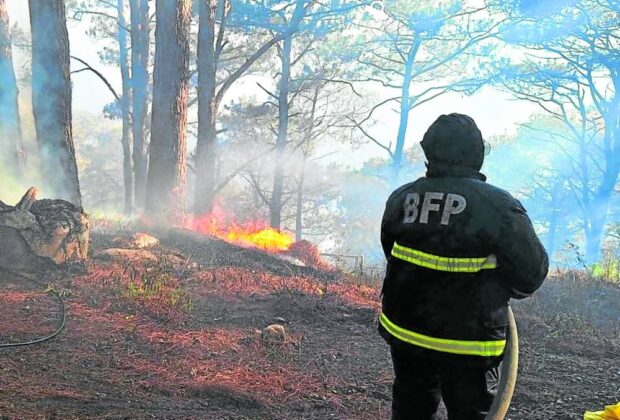
MOUNTAIN BURNING The dry condition in the Cordillera region has contributed to forest fires that have so far hit more than 200 hectares in Mountain Province and Benguet since last month. —PHOTO COURTESY OF BAGUIO CITY FIRE STATION
BAGUIO CITY—A succulent plant will soon make up the planned kilometers-long greenbelts that should contain fires erupting in the mountainous Cordillera following conclusive tests that were completed in March, officials of the Department of Environment and Natural Resources (DENR) revealed on Monday.
Wildfires had consumed over the years some 9,702 hectares of natural forests and more than 3,000 ha of tree plantations in the region, mostly in Benguet and Mountain Province.
Around 80 percent to 90 percent of the maguey plant (Agave cantala) “is water,” enabling the succulent to absorb extreme heat, said Helen Madumba, chief of the Watershed and Water Resources Research Development and Extension Center (WWRRDEC) in Baguio, at a press briefing.
Redirection
The maguey greenbelt should redirect the spread of forest fires away from upland settlements, she said.
Researchers already put up a 5.12-km maguey greenbelt at the Benguet towns of Tublay and Bokod as proof of concept through a three-year project financed by the Philippine Council for Agriculture, Aquatic and Natural Resources Research and Development that began in 2021, she said.
WWRRDEC picked maguey, which is grown to promote slope stabilization, following initial research initiated by a former DENR official, said Rhandy Tubal, the project leader. Tests concluded that Maguey could withstand “extreme heat” and harsh environmental conditions.
Recurring hazard
Forest fires frequently occur in the region during March at the start of the dry season, often due to untended grass fires, cigarettes, kaingin (slash-and-burn farming), and, recently, the effects of climate change.
As of June 3, multiple blazes caused by the dry spell spawned by the El Niño phenomenon since the start of the year destroyed P74 million worth of pine growth and grasslands in parts of Benguet near Baguio City, Sabangan town in Mountain Province, Pinukpuk town in Kalinga province, Abra’s Lagangilang municipality, and Calanasan town in Apayao province, according to reports from provincial and community environment and natural resources offices.
The widest timber areas destroyed by fire in the first half of 2024 were Benguet’s forests near Baguio (8,314.29 ha) and in the vegetable-growing town of Buguias (679.57 ha), followed by 635.33 ha in Sabangan, the DENR report showed.
Fire danger rating
Madumba said her agency has a new research proposal to determine the “fire danger rating of our watersheds,” and draw up a procedural manual to reduce forest fires.
DENR said the region’s forest cover increased by 10 percent, from 781,000 ha of timberland in 2010 to 857,000 ha in 2020. Although the government credits its regreening program, part of the increase must be attributed to the Cordillera ecosystem’s natural regeneration, which must also be protected, said Paquito Moreno, the DENR Cordillera director.
Maguey takes five years to reach full maturation, but each plant within the first year of growth can already reduce soil erosion, Tubal said. It grows 2.5 centimeters three months after planting.
Some concerns
Some researchers have been concerned about maguey’s long-term impact on local flora because it is technically an invasive species, not a homegrown mountain plant, Tubal admitted. But the project had no adverse effects. Wild maguey, he said, actually grew in isolated areas where no other major plants thrived.
About 1.28 km of maguey are located at Barangay Daclan in Tublay, while 3.84 km traverse the borders of Barangays Bobkok-Bisal, Poblacion and Pito in Bokod, Madumba said.
Two maguey nurseries were put up in Bobkok-Bisal and Daclan to grow replenishment for the greenbelts. The communities are also being taught fibercraft skills using maguey as another benefit from maintaining the succulents, she said.